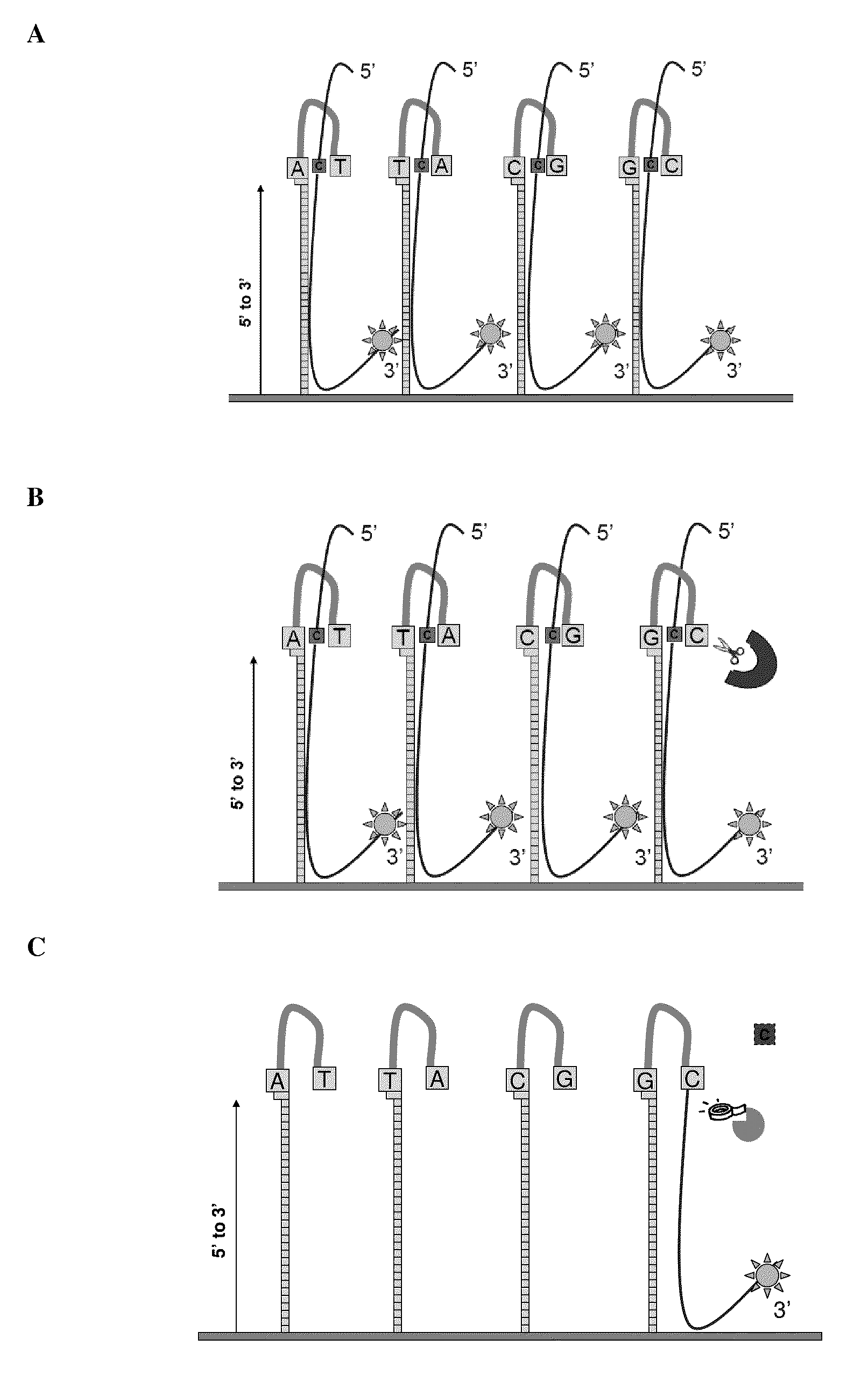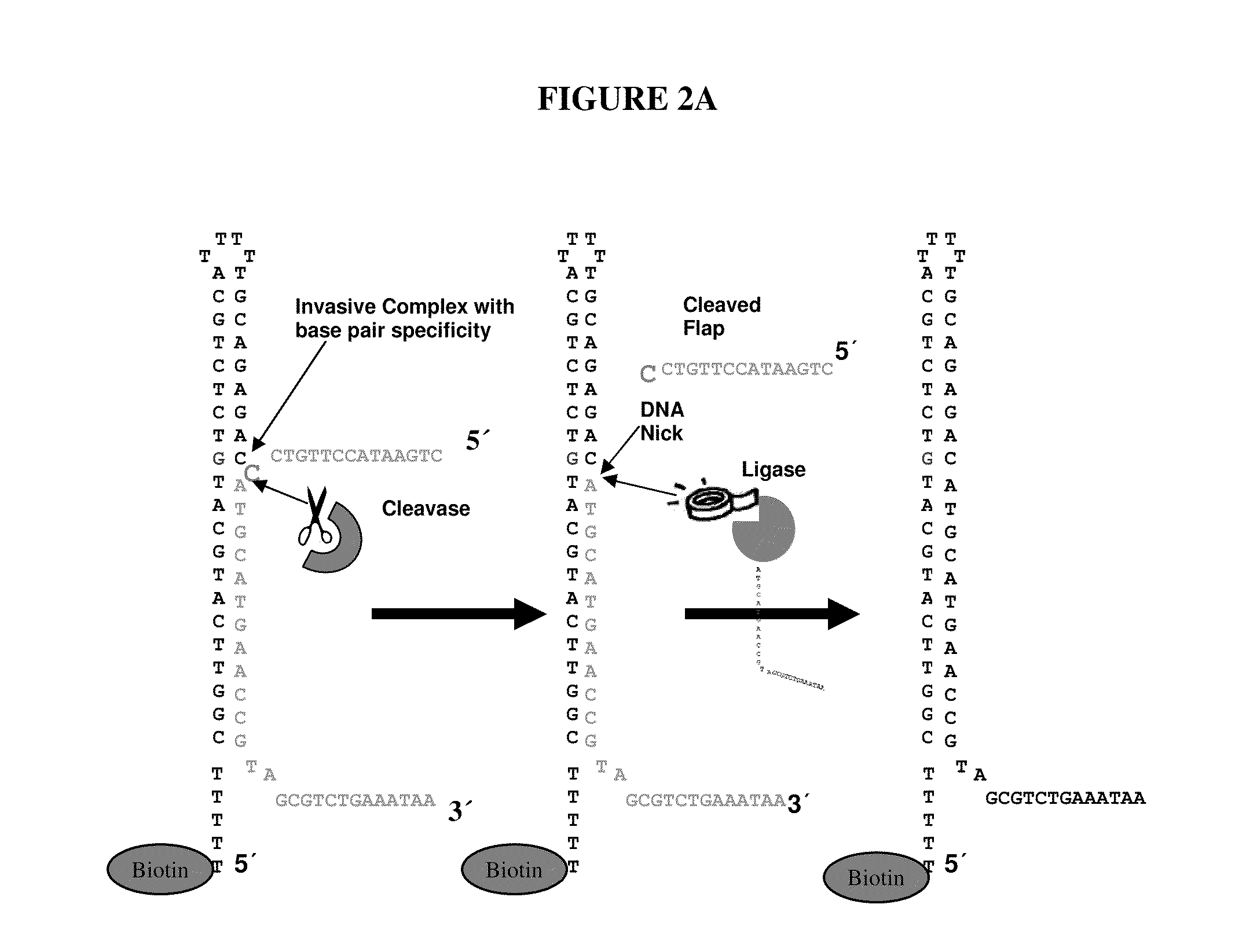Methods and Assays for Capture of Nucleic Acids
a nucleic acid and assay technology, applied in the field of sequence specific nucleic acid target capture, can solve the problems of time-consuming, and costly task, and identifying such snps, and reducing the complexity of the genom
- Summary
- Abstract
- Description
- Claims
- Application Information
AI Technical Summary
Benefits of technology
Problems solved by technology
Method used
Image
Examples
example 1
Target Capture of Creatine Phosphokinase 6 (CPK6) and Restriction Fragmented PCR Amplicons
[0080]Experiments were designed to test for ligation efficiencies in methods and assays of the present invention. Experiments were designed utilizing 3′ labeled CPK6 oligonucleotides (Integrated DNA Technologies (IDT), Coralville Iowa) and PCR fragments amplified from E. coli genomic DNA (ATCC No. 700926D-5) yielding amplicons from around 1100 to around 1500 bps (SEQ ID NO: 2, 3 and 4). Oligonucleotide probes of 50 and 60 mers were designed that comprised a 16 bp hairpin. The hairpin sequence used was 5′-CCGGAGGATACTCCGG-3′ (SEQ ID NO: 1), as shown in FIG. 3. Control probes were synthesized that did not contain hairpin structures. A quartet of probes was designed representing all four bases per strand, as such eight total probes were designed (e.g., 4 for each strand of the DNA target) for the target nucleotide within the query sequence. Each quartet per strand contained the same probe sequence...
example 2
Target Capture of Creatine Phosphokinase 6 (CPK6) and PCR Amplicons
[0085]Experiments were designed to test for flap endonuclease and ligation efficiencies in methods and assays of the present invention. Experiments were designed utilizing a 3′ labeled CPK6 oligonucleotides (IDT) and PCR fragments amplified from E. coli genomic DNA as described in Example 1. Oligonucleotide probes of 50 and 60 mers were designed that comprised a 16 bp hairpin and a complementary base on the terminal 3′ end. The hairpin sequence used was 5′CCGGAGGATACTCCGG3′ (SEQ ID NO: 1). Control probes were synthesized that did not comprise hairpin structures. A quartet of probes was designed, as exemplified in FIG. 1A, representing all four bases per strand, as such eight total probes were designed (e.g., 4 for each strand of the DNA target) for the target nucleotide within the query sequence. Probes were synthesized in situ at Roche NimbleGen (Madison, Wis.) on an array with a density of 2.1 million probes per ar...
example 3
Target Capture of Creatine Phosphokinase 6 (CPK6) and Randomly Fragmented Genomic DNA
[0089]Experiments were designed utilizing human and E. coli genomic DNA (gDNA). Oligonucleotide probes were designed as described in Example 1, such that probes were synthesized in situ at Roche NimbleGen (Madison, Wis.) at a density of 2.1 million probes per array (HD2). Genomic DNA (gDNA) was fragmented either with sonication or randomly amplified using Klenow fragment with random primers of various lengths (9 mers, 10 mers, 12 mers, and 15 mers) yielding amplified target sequences of differential lengths. The fragments were treated with antarctic phosphatase and labeled with Cy3-ddCTP on their 3′ ends using terminal transferase (TdT) and precipitated away from non-labeled fragments using methods known to those skilled in the art. The microarray slides were sealed with HX3 mixers (NimbleGen Roche) and denatured, labeled target sequences were applied to a microarray (5-30 μg sample / subarray). Probe...
PUM
| Property | Measurement | Unit |
|---|---|---|
| Fluorescence | aaaaa | aaaaa |
| Thermal stability | aaaaa | aaaaa |
Abstract
Description
Claims
Application Information
 Login to View More
Login to View More - R&D
- Intellectual Property
- Life Sciences
- Materials
- Tech Scout
- Unparalleled Data Quality
- Higher Quality Content
- 60% Fewer Hallucinations
Browse by: Latest US Patents, China's latest patents, Technical Efficacy Thesaurus, Application Domain, Technology Topic, Popular Technical Reports.
© 2025 PatSnap. All rights reserved.Legal|Privacy policy|Modern Slavery Act Transparency Statement|Sitemap|About US| Contact US: help@patsnap.com



